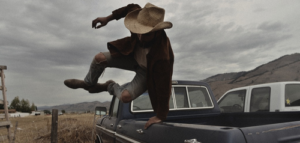Cowboy Up
 Out west, we have a variation on “Man Up.” I hear, and have often said, “Cowboy Up.”
Out west, we have a variation on “Man Up.” I hear, and have often said, “Cowboy Up.”
It’s a version of the Man Box that calls forth the romance of the old west. A man with a gun and his horse. He’s alone. He’s willing to get his hands dirty. He sleeps under the stars with his boots on. He can hold his liquor, shoot straight, and doesn’t ask for help. The Colt 45 at his hip serves justice to the immoral and corrupt out on the vast plains. Women desire him, men envy him, and Natives fear him.
We’ve known him by many names – some real and some fiction – Billy the Kid, Will Rogers, The Lone Ranger, Doc Holiday, Wyatt Earp, Jesse James, Josey Wales, Cordell Walker, and on. Hollywood has ensured that John Wayne and Clint Eastwood are embedded in our collective image of what a cowboy is. He barks, grumbles, or remains silent. But most often he settles the score with a bullet.
When we see the cowboy surrounded in the movies, the first thing he is told to do is drop his gun. The grimace and glint in his eye as the camera zooms in on his grizzled face tell us that this is a deep insult to his manhood and in act three we can expect someone to pay with their life. The cowboy without his gun is not fully a cowboy. While the cowboy hat may be his uniform, the gun is his purpose. It is the one tool that he will sacrifice everything else for. He will run into the desert barefoot in his underwear – as long as he has his gun.
Over time, society has transformed him from a lone gunman on the prairie, into a variety of characters who each face impossible odds and end up triumphing through the indiscriminate use of violence. Rambo, John McClane, James Bond, Jason Bourne, Harry Callahan, Blade, John Wick, Frank Castle, and on.
These men are idolized – they are heroes to many. If they represent the ideal man, is it any wonder that men and boys turn to violence to solve problems that feel insurmountable?
Ninety-eight percent of mass shootings are committed by men, and 57 percent have a history of domestic violence. The connection between masculinity and gun violence is undeniable.
The culture of violence we live in today is built upon a foundation of male dominance. The contemporary terminology deems it “toxic masculinity,” but I tend to agree with my friend Ted Bunch who says; “when we label this kind of behavior ‘toxic masculinity,’ that gives the majority of men an out.” The truth is: all men are socialized to uphold an ideal of masculinity that validates and even encourages violence.
When we dig into the collective socialization of men, we find that the cowboy has given us all the clues we need to decode this epidemic of violence. He is isolated, unwilling to ask for help, and solves his problems with violence.
To Cowboy Up is to Man Up. It is an admonition and a challenge given to men to live within the confines of the Man Box, in the company of our nostalgic cowboy icons like John Wayne and modern day “real men” like Frank Castle.
It’s time for the cowboy to wander into the sunset playing a sad tune on his harmonica. It’s time for him to lay down his gun and remember how to be vulnerable. It’s time for men’s violence towards women, trans and gender non-conforming people, and feminine men to end. And it’s up to men to show other men how it’s done.
We can become role models for the men and boys in our lives. It begins with valuing women and girls. Not as our possessions, but as complex individuals equal to ourselves. Not as sexual conquests, but as friends, co-parents, colleagues, mentors, and role models. Not as objects, but as living, breathing human beings full of all the same strengths and weaknesses that we as men experience. It continues by allowing men and boys to be our authentic selves. We must create space for men to show emotion, to ask for help, to learn to follow and find solutions without violence.
We learned manhood from the generations of men who came before us. What we teach the next generation is up to us.
Scott Davis, A Call To Men Core Trainer